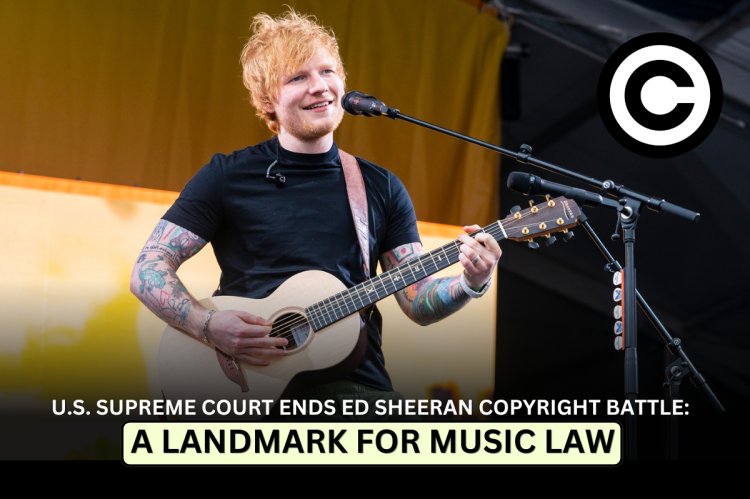U.S. Supreme Court Ends Ed Sheeran Copyright Battle: A Landmark for Music Law
The U.S. Supreme Court's rejection of the Ed Sheeran copyright case marks a critical precedent in music law, affirming that basic musical elements like chord progressions are not protected under copyright. This ruling strengthens creative freedom while clarifying the legal scope of infringement in the music industry.

Introduction
In June 2025, the U.S. Supreme Court rejected an appeal in the case filed by Structured Asset Sales (SAS) against singer-songwriter Ed Sheeran, ending a lengthy copyright battle. The main point of contention was that Sheeran's 2014 single "Thinking Out Loud" violated the copyright of Marvin Gaye's 1973 smash song "Let's Get It On." The Supreme Court has established a crucial precedent for the protection of musical works under U.S. copyright law by declining to resurrect the case, upholding the rulings of the lower courts.
This legal dispute is important for the music industry and copyright law in general, not just for Sheeran or the Gaye estate. In an age of digital creation and widespread music consumption, it touches on fundamental issues of originality, authorship, copyright scope, and the extent to which musical overlap amounts to infringement.
Background of the Dispute
The litigation started when Sheeran was sued in a federal court in New York by SAS, a company that had purchased stock in Ed Townsend's (Gaye's co-writer) “Let's Get It On”. The main accusation was that “Thinking Out Loud” copied the chord progression, harmonic rhythm, and groove of Gaye's song, among other important musical components.
Notably, this was not the first case involving the same music. A similar lawsuit had been made by the Townsend family before, and it went to trial before a jury, which decided in Sheeran's favour in 2023 that any resemblances were too general to be protected by copyright. SAS persisted in pursuing its own claim, contending that “Thinking Out Loud” violated protected aspects of Gaye's compositions, including the original's sound recording and performance elements in addition to the written sheet music.
The district court decided against SAS in 2023, stating that U.S. copyright law only protects the song as registered, in this case, the deposit copy (the sheet music filed with the Copyright Office), and that the musical elements in question were too common to be protected. In 2024, the Second Circuit Court of Appeals upheld that ruling. The decision is now definitive because the Supreme Court has decided not to consider the appeal.
Legal Issues and Judicial Reasoning
1. Protectable Expression vs. Common Elements
The fact that copyright law protects unique expressions rather than concepts or widely used elements is one of its most basic tenets. This implies that fundamental building blocks in music, such as standard chord progressions or rhythmic patterns, cannot be protected. The judges determined that these unprotectable elements served as the foundation for the two songs' melodic similarities.
Simple progressions like I-iii-IV-V, which are utilised in many popular songs, are in the public domain and cannot serve as the foundation for infringement claims, according to the opinion, which supported the long-held position of the U.S. Copyright Office.
2. Deposit Copy Doctrine
The court emphasised that only the information included in the registered deposit copy is legally protected. SAS attempted to contend that certain aspects of the sound recording or performance, but not the sheet music, were likewise protected. The courts rejected this, making it clear that a copyright claim cannot be based on unregistered parts.
This establishes a crucial procedural precedent: if a song's producers want to safeguard their unique elements, they must make sure that all of them, including arrangements and stylings, are registered.
3. Balancing Creative Freedom and Protection
In the controversial Blurred Lines case (Gaye estate v. Robin Thicke and Pharrell Williams), a jury found in favour of the Gaye estate because of the purported infringement of "Got to Give It Up." That case is followed by this litigation. The decision drew criticism for blurring the line between inspiration and imitation. However, the Ed Sheeran verdict restricts the scope of copyright protection and avoids penalising artistic impact.
Implications for the Music Industry
A. A Victory for Musical Creativity
Artists who were concerned that using common musical instruments could put them in danger of legal repercussions now have clarity and relief thanks to the Supreme Court's ruling. "I'd be quite an idiot to stand on a stage in front of 20,000 people and do that if I had done what I'm being accused of doing," Sheeran himself said during the trial. The decision confirms that basic musical themes cannot be monopolised and that inspiration is not infringement.
B. Challenges for Copyright Claimants
The ruling is a blow to litigants like SAS. Unless unique, registered pieces are copied, it limits their capacity to assert copyright infringement. But SAS has hinted that it might look into other legal theories based on the handwritten sheet music and sound recording, which might lead to future legal issues.
C. Policy and Legal Precedent
For courts examining related cases, the ruling can establish a precedent. It strengthens the need for objective legal benchmarks in assessing infringement and promotes judicial scepticism of claims based on nebulous musical similarities.
It might also advocate for changes to the way music copyright is registered, like broadening the list of protected elements or enhancing the rules for registering expressive elements other than written notation.
Conclusion
The Supreme Court's ruling to dismiss the copyright complaint against Ed Sheeran's Thinking Out Loud marks a major turning point in music copyright jurisprudence, in addition to ending a drawn-out legal struggle. By reiterating that essential musical elements cannot be monopolised and emphasising the significance of registered content in copyright claims, the decision supports creative freedom and gives artists, producers, and copyright holders much-needed clarity.
As generative technology and AI-generated music become more common, this case might be more important in defining the line between inspiration and infringement as well as in determining the future course of music copyright litigation.
The Thinking Out Loud decision reinforces that only unique expressions—not common musical elements—are protected, providing important advice for India's copyright environment. In contrast to the United States, India does not require registration; instead, courts use subjective standards such as "look and feel." The case emphasises the need for more precise guidelines, robust safeguards, and a fair balance between artistic inspiration and infringement.
Co Author – Diksha Modi












